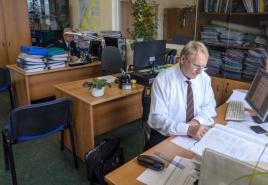Role in the biosphere of living organisms of the kingdom of bacteria. The use of knowledge about the biogeochemical activity of microorganisms in biology lessons cycles of organic matter
The biosphere of the planet is a single megaorganism, the parts of which are harmoniously interconnected. All the diversity of life is divided into two kingdoms - prokaryotes (pre-nuclear organisms) and eukaryotes (having a nucleus). Superkingdoms are subdivided into living kingdoms:
- viruses;
- bacteria;
- mushrooms;
- plants;
- animals.
The kingdom of bacteria, together with the kingdom of viruses, is combined into the super-kingdom of prokaryotes - non-nuclear organisms. Historically, this is the first echelon of living organisms on the planet.
Living unicellular organisms appeared about 3.8 billion years ago. For almost a billion years, they were the only living inhabitants of the planet - they successfully multiplied, developed and adapted. The result of their vital activity was the appearance of free oxygen in the atmosphere of the planet, which allowed the emergence of multicellular organisms - fungi, plants, flowers and animals.
Nowadays, living bacteria live everywhere: from the rarefied atmospheric layers to the deepest ocean trenches, they live in arctic ice and in thermal geysers. Bacteria have populated not only free space - they feel great inside other organisms, be it fungi, plants or animals.

In nature, all animals, and man is no exception, are a habitat for microbes that inhabit:
- skin;
- oral cavity;
- intestines.
Researchers have found that the number of cells of microorganisms living in the human body is 10 times higher than the number of its own cells. Despite such high quantitative indicators, the weight of bacteria living in the body does not exceed 2 kg - a significant difference in cell size affects.
Living representatives of the kingdom of bacteria have an innumerable number of species, but the common thing for all of them is:
- lack of a pronounced nucleus;
- very small (compared to plant and animal cells) cell sizes;
- the biological unit is the cell itself; in the case of their association, we are talking about a colony of bacteria.
It was representatives of the kingdom of bacteria that made possible the appearance of fungi, plants and animals. Having appeared on the planet, microorganisms not only adapted to the existing conditions - they actively changed their habitat, creating qualitatively new characteristics.

The cycle of nitrogen and carbon in nature occurs exclusively due to microorganisms. Scientists have found that if microbes are removed from the biosphere, life on the planet will not be able to survive.
The role of prokaryotes in biospheric cycles
At the origin of life on the planet, representatives of the kingdom of bacteria actively participated in the formation of the biosphere. The modern biosphere needs microorganisms to maintain the level of functioning - the cycle of energy and matter in nature is provided by microbes.
Examples of the dominant role of living microbes in biospheric processes are the creation and maintenance of a fertile soil layer.
In addition to gas and oxidizing functions, the geochemical functions of microorganisms are becoming increasingly important. Enzymatic activity and concentration functions have a significant impact on the geochemistry of the planet.
Species diversity of microorganisms
Representatives of the kingdom of bacteria inhabited all levels of the biosphere, and by the presence of microbes they determine the upper and lower boundaries of the planet's biosphere. Living in environments so different in physical parameters, microbes differ in a number of ways.
- According to the shape of a living bacterial cell:
- spherical cocci;
- rod-shaped;
- convoluted, subdivided into vibrios and spirochetes.
- According to the way the body moves in space:
- without flagella (chaotic movement similar to Brownian);
- with the help of flagella (the number varies from one to many around the entire perimeter).
- According to the peculiarities of the metabolism of representatives of the kingdom of bacteria:
- synthesis of necessary substances from inorganic matter - autotrophs;
- processing of organic matter - heterotrophs.
- By way of obtaining energy:
- respiration (aerobic and anaerobic microorganisms);
- fermentation;
- photosynthesis (oxygen-free and oxygen).

Features of the relationship between microbes and viruses - representatives of the kingdoms of the same name
The superkingdom of prokaryotes combines two kingdoms - bacteria and viruses, which have much more differences than common features. For example, if bacteria synthesize all the substances necessary for life support, then viruses are generally not capable of protein synthesis. They cannot even reproduce their own kind on their own, but only by infiltrating someone else's cell.
Viruses block the DNA of the host cell and replace it with their own - as a result, the captured cell produces copies of the invading virus, which usually leads to its death.
The term " biosphere”was introduced into scientific literature at the end of the 19th century. geologist E. Suess to designate a special earthly shell inhabited by living organisms. A holistic doctrine of the biosphere was created in the first half of the 20th century. the largest naturalist-geochemist V. I. Vernadsky.
Based on an analysis of the history of atoms in the earth's crust and in its upper, engulfed by life, shell, Vernadsky came to conclusions of exceptional theoretical and, as it later became clear, practical significance. He showed that the biosphere is not only inhabited by living organisms, but also to a significant extent geochemically reworked by them; it is not only a living environment, but also a product of the vital activity of living organisms that have lived on earth at all geological times - the living substance of the planet. A. I. Perelman proposed to call this provision, which is of exceptionally great importance for geochemistry, “Vernadsky’s law” and formulated it as follows: “The migration of chemical elements in the biosphere is carried out either with the direct participation of living matter (biogenic migration), or it proceeds in the environment , the geochemical features of which (O 2, CO 2, H 2 S, etc.) are due to living matter, both the one that currently inhabits this system and the one that acted in the biosphere during geological history "(Perelman , 1979, p. 215).
At an early stage in the development of biology, there was an idea that all life living on Earth is divided into two "kingdoms" of organisms: flora and fauna, or the plant kingdom - Plantae and the animal kingdom - Animalia. In the XVIII-XIX centuries. from the moment of discovery and subsequent intensive study of the world of microorganisms, it became necessary to distinguish a new third kingdom of living beings, called by Haeckel (1866) the kingdom of protists. The emergence of new branches of biology, in particular molecular biology, the improvement of microscopy techniques, the use of electron microscopy, the development of new modern methods for studying microorganisms, contributed to the further identification of new kingdoms of living nature; in modern classifications, five kingdoms are separated, united according to the type of cell structure into two groups (R. Murray, 1968; R. Whittaker, 1969):
animal kingdom - Animalia
Eukaryotes plant kingdom - Plantae
kingdom of protists - Protista
mushroom kingdom - Mycota
Prokaryotes bacterial kingdom - Procaryota
The prokaryotic type of microbial cell is characteristic of bacteria, actinomycetes and blue-green algae. Its main feature is the absence of a clear boundary between the nuclear substance and the cytoplasm and the absence of a nuclear membrane. The region of the nucleus (the so-called nucleoid) is filled with DNA that is not associated with a protein and does not form structures similar to eukaryotic chromosomes. There are also no mitochondria and chloroplasts, and the cell wall consists of a heteropolymeric substance, which is not found in any of the eukaryotic organisms. In the cytoplasm of photosynthetic bacteria there are thylakoids containing pigments (chlorophylls and carotenoids), with the help of which photosynthesis is carried out. In some types of bacteria, granules of fat and volutin accumulate in the cells.
The eukaryotic cell type is characteristic of fungi, algae, protozoa (similar to plant, animal and human cells). It is more complex: the nucleus with a two-layer nuclear porous membrane is separated from the cytoplasm, it contains one or two nucleoli, inside which RNA (ribonucleic acid) is synthesized and contains chromosomes - carriers of hereditary information, consisting of DNA and protein. In the cytoplasm there are also mitochondria (participating in the processes of respiration) and in algae chloroplasts (converting radiant energy into chemical energy).
According to absolute geochronology and paleontology, using the latest methods of biochemistry, life already existed in the Archaean 4-3.5 billion years ago. During deep reference drilling, set in the USSR on the Russian platform, in the metamorphosed sedimentary rocks of the Archaean, many carbonaceous products of the transformation of the first photosynthetic organisms - blue-green algae and the smallest organic bodies of bacterial origin were found. These prokaryotic organisms - bacteria and cyanophytes, which appeared in an oxygen-free atmosphere (but possessing a photosynthetic apparatus) - the only inhabitants of the Earth for more than 1 billion years, were the first producers of free oxygen in its atmosphere.
At the end of the Archean and the beginning of the Proterozoic - 2.6-2.2 billion years ago - the Earth's atmosphere already contained enough oxygen to carry out oxidative processes. Sulfates (products of sulfide oxidation) and lateritic bauxite-bearing formations containing Fe oxides have been found in rocks of this age (Sidorenko, Tenyakov, and others). Iron bacteria have been found in Proterozoic rocks aged 2 billion years (Zavarzin, 1972). Thus, already in the Archean and Lower Proterozoic, as a result of the gaseous and oxidizing functions of microorganisms, the sphere of the Earth inhabited by them was transformed to such an extent that it acquired the geochemical features of the modern biosphere.
The presence of free oxygen in the atmosphere has become a condition for the development of diverse forms of life - eukaryotic protozoa and multicellular plants and animals. The diagram of the evolution of the organic world, according to the ideas of the paleontologist Academician B.S. Sokolov, shows the main stages in the development of life not only in the Paleozoic and Mesozoic (which paleontology has been studying for a long time), but also in the Archaean, Aphebia (Middle and Lower Proterozoic) - a long period of the history of the Earth, when the simplest organisms dominated, and more complex ones appeared in the Riphean (Upper Proterozoic). The most ancient bacteria, blue-green algae (cyanophytes), fungi, protozoa, with the activity of which the formation of the biosphere is associated, have existed at all geological times and continue to exist today.
With the development and differentiation of life forms, all ecological niches of the biosphere were mastered, and their geochemical activity became more and more diverse. Along with gas and redox functions, the concentration functions of living organisms have acquired colossal planetary significance, especially pronounced in relation to C, Ca, Si.
The photosynthetic activity of organisms and the concentration of carbon and solar energy in the form of organic substances determined the global distribution of the formation of carbonaceous-siliceous and oil shale in the Proterozoic and Paleozoic. The development of marine fauna with a calcareous, phosphate, and siliceous skeleton in the Cambrian marked the beginning of the accumulation of thick suites of organogenic rocks, which continued in all subsequent geological epochs. The formation of these rocks is largely associated with the activity of microorganisms: lithified cells of cocolithophores are found in all calcareous sediments; accumulations of flint skeletons of diatoms and radiolarians form diatomites and tripoli.
A variety of geochemical functions of microorganisms, their high enzymatic activity significantly affect the geochemical processes of the modern biosphere.
The biosphere includes several geospheres: the troposphere, the hydrosphere (the World Ocean), the pedosphere and the upper part of the lithosphere - the crust and the weathering zone, the strata of sedimentary rocks up to the boundaries of the spread of life.
Living matter is unevenly distributed in the biosphere; places of the greatest concentration of living organisms and a variety of forms - soils, bottom sediments of lakes, tidal zones of sea coasts and shallow water shelves, the upper euphotic layer of the waters of the seas and oceans. As you move away from the surface of the Earth, the density of life and the diversity of species decrease. Life penetrates most deeply from the surface of the Earth in the World Ocean: the entire water column and the part of the bottom sediments accessible for observation are inhabited; at the bottom of the deepest oceanic trenches, such as the Mariana (11,022 m) and Philippine trenches (over 10,000 m) and others, there is a peculiar abyssal fauna, a diverse microflora.
On land, living cells of microorganisms were found in the thickness of the lithosphere at a shallower depth: when drilling wells in groundwater at 1500-2000 m, in oil-bearing waters at 4500 m. The penetration of organisms into the depths of the lithosphere is prevented by temperatures exceeding 100 ° C.
The upper limits of the biosphere, apparently, coincide with the boundary of the troposphere (11,000 m above sea level); it is possible for microorganisms to enter the stratosphere. However, active life at high absolute altitudes is limited not so much by low temperatures as by the lack of liquid water and carbon dioxide: the partial pressure of CO 2 at an altitude of 5600-5700 m is 2 times less than at sea level. Live, actively developing algae, fungi, bacteria are found in the mountains at altitudes of 6200-6500 m, where they are distributed not only on rocks, but also on the surface and in the thickness of firn and ice.
Consequently, microorganisms are settled within the entire biosphere and are indicators of its lower and upper boundaries: they develop in a wide range of environmental conditions, form colossal concentrations in places of general concentration of life, and fill ecological niches in extreme conditions where the life of higher organisms is impossible.
Such a wide distribution is facilitated, firstly, by the small mass and size of bacteria - 1-2 microns, yeast cells, fungal spores - about 10 microns. With water, they penetrate into the finest hairline cracks of rocks, reaching deep aquifers, rise to the upper boundaries of the troposphere, carried away by air currents, fly into the stratosphere, make global movements and inhabit the glaciers of Greenland and Antarctica.
Microorganisms are very hardy, tolerate severe desiccation and do not lose viability, living cells contain 80-85% water. Dried spores of mold fungi, some bacilli, containing only 40% water, retain the ability to germinate for 10-20 years. Non-spore-bearing, microorganisms withstand drying for several months.
In the dried state, microorganisms are resistant to direct sunlight and high temperatures, so abundant microflora lives on the surface of soils, rocks and rock fragments in deserts.
The vast majority of microorganisms tolerate low temperatures well. Experiments carried out in laboratories (Becquerel, 1925) showed that bacterial and fungal spores that were kept for half a year or more at liquid air temperature (-190°C) did not die and retained the ability to germinate. When pumping air, in a rarefied atmosphere, they withstood even lower temperatures. Evidence of the endurance of microorganisms to low temperatures is their wide distribution in the nival belt of mountains, polar regions, permafrost horizons of soils and soils. Many microorganisms are able to go into a state of anabiosis under adverse conditions. At the slightest improvement in the external environment, they return to life: the assimilation of water, carbon dioxide begins, rapid reproduction, for example, the division of micrococci occurs every half hour. In places where life is concentrated, millions and billions of cells of various microorganisms inhabit every cubic centimeter of natural waters, soils and bottom sediments.
The ubiquitous distribution of microorganisms, the high speed of life cycles, along with the variety of functions performed, determine their exceptional role in the geochemical processes of the biosphere. The study of the geochemical functions of living matter in the biosphere is the main task of biogeochemistry, founded by V. I. Vernadsky; its intensive development began in the middle of the 20th century, when, in connection with the ever-increasing technogenic activity of mankind, the problems of environmental protection arose.
All geochemical functions of microorganisms in the biosphere can be divided into the following types with a certain degree of conventionality:
1) assimilation - in relation to the gases of the atmosphere and the creation of organic matter;
2) destructive - in relation to organic matter;
3) gas - regulation of the gas regime of soils, reservoirs, surface atmosphere;
4) redox - in relation to macro - and microelements with variable valency;
5) destructive - in relation to rocks and minerals;
6) accumulative functions and the creation of biogenic minerals and rocks.
If you find an error, please highlight a piece of text and click Ctrl+Enter.
Question 1. Describe the role of prokaryotes in the biosphere.
Prokaryotes carry out photosynthesis, thereby producing oxygen into the atmosphere. Chemosynthesis is very common among prokaryotes. In addition, among bacterial organisms there are nitrogen-fixing forms: this is the only group of living organisms on our planet that are able to assimilate nitrogen directly from atmospheric air and thus involve molecular nitrogen in the biological cycle.
Also, prokaryotes have another important function: the return of inorganic substances to the environment through the destruction (mineralization) of organic compounds.
At the level of the biosphere as a whole, prokaryotes, primarily bacteria, have another very important function - concentration. They are able to actively extract certain elements from the environment even at their extremely low concentrations.
The properties and functions of prokaryotes are so diverse that, in principle, they are able to create stable functioning characteristic (that is, only with their participation) ecosystems.
Question 2. Explain what is the danger of introducing prokaryotic drugs into the natural environment to combat its pollutants.
One of the problematic issues that arise during the introduction of prokaryotes into the environment is the establishment of the nature of the relationship between one's own microflora and the introduced one. The possibility of a negative impact of introduced microorganisms on the state of natural biogeocenoses as a result of a change in the existing balance in microbiocenoses is not excluded. This circumstance requires with great care and only after careful research to use prokaryotes for human needs and in the fight against pollutants of the biosphere.
Question 3. It is known that all the most diverse nitrogen-fixing bacteria have the same nitrogenase enzyme, which catalyzes the binding of molecular nitrogen. What is the significance of this fact in the evolution of living nature?
Nitrogenase is a multidimensional enzyme consisting of a complex of two proteins. Nitrogenases from different nitrogen fixers differ somewhat in their molecular weights and metal content. This fact indicates the unity of the origin of nitrogen-fixing bacteria. Nitrogenase appeared in the ancestral form of bacteria, then there was a divergence that led to a variety of nitrogen-fixing bacteria, each of which had a gene encoding nitrogenase.
The process of nitrogen fixation takes place at normal atmospheric pressure and temperature, but requires a lot of energy.
Microaerophilic conditions are necessary for the active work of nitrogenase. Molecular oxygen has a damaging effect on both nitrogenase proteins. Microaerophilic conditions in the nodule are provided by a diffuse barrier to oxygen. The nitrogenase complex, which forms ammonia from the air, acts very sparingly. If there are enough ammonium ions or nitrates in the habitat, it stops working.
Nitrogen is an absolutely essential element for all living organisms. The main reservoir of nitrogen is the Earth's atmosphere. Eukaryotic organisms are not able to absorb nitrogen directly from the atmosphere. Due to the presence of the enzyme nitrogenase, which catalyzes the binding of molecular nitrogen, in nitrogen-fixing bacteria, plants living in symbiosis with them can obtain nitrogen readily available to them. Many plants, animals, and fungi have the ability to enter into symbiosis with nitrogen-fixing prokaryotes.
Question 4. American biologist and ecologist Barry Commoner in the early 70s. 20th century put forward the thesis as a law of ecology: "Nature knows best." Explain what was meant. Express your opinion on this matter. Explain your answer with examples.
Barry Commoner says that as long as there is no absolutely reliable information about the mechanisms and functions of nature, we, like a person who is unfamiliar with clocks, but wants to fix them, easily damage natural systems by trying to improve them. He calls for extreme caution. The transformation of nature is detrimental economically and dangerous ecologically. Ultimately, conditions unsuitable for life may be created. The existing opinion about the improvement of nature without specifying the ecological criterion of improvement is devoid of any meaning.
I agree with this opinion. We often do not think that one manifestation of nature is the result of a more destructive and detrimental phenomenon for biocenoses, biogeocenoses, or for the biosphere as a whole. “The main thing is that we feel good,” and nature will wait. You can not do it this way!!!
Examples can be given about the shooting at one time of wolves, which turned out to be "orderlies of the forest." In China, sparrows were destroyed, which supposedly destroy crops, but no one thought that crops without birds would be destroyed by harmful insects.
Answer from Cat[guru]
Prokaryotes carry out photosynthesis differently than plants. Bacteria use the pigment bacteriochlorin in this process.
and do not release oxygen into the environment. Photoautotrophic archaebacteria carry out photosynthesis with the help of bacteriorhodopsin, and cyanobacteria, in addition to chlorophyll, additionally have two other pigments: phycocyanin and phycoerythrin. These facts show that nature has provided several pigments for the implementation of the synthesis of primary organic matter, which significantly expand the spectral composition of the radiation available for photosynthesis. Chemosynthesis is very common among prokaryotes. In addition, among bacterial organisms there are nitrogen-fixing forms: this is the only group of living organisms on our planet that are able to assimilate nitrogen directly from atmospheric air and thus involve molecular nitrogen in the biological cycle.
Bacteria and blue-greens include up to 90% of all nitrogen included in the biogenic cycle in the composition of organic matter; the remaining 10% of the nitrogen is bound by lightning electrical discharges. It follows from the foregoing that the most important function of prokaryotes in the biosphere is the involvement in the circulation of elements from inert (non-living) nature.
At the same time, prokaryotes also have another important function, directly opposite to the first one: the return of inorganic substances to the environment through the destruction (mineralization) of organic compounds. Heterotrophic bacteria function not only in soil and water, but also in the intestines of many animals, where they intensively affect the conversion of complex carbohydrate compounds into simpler forms.
At the level of the biosphere as a whole, prokaryotes, primarily bacteria, have another very important function - concentration. Research has established that microorganisms are able to actively extract certain elements from the environment even at extremely low concentrations. For example, in the waste products of some microorganisms, the content of iron, vanadium, manganese and a number of others is hundreds of times higher than in their environment. The activity of bacteria actually created natural deposits of these elements.
The properties and functions of prokaryotes are so diverse that, in principle, they are able to create stable functioning characteristic (that is, only with their participation) ecosystems. Not without reason, in the history of life on Earth for almost 2 billion years, it was represented by prokaryotes. "It was cyanobacteria that first populated the Bikini Atoll after a nuclear explosion and the island of Surrey, which arose in 1963 as a result of the eruption of an underwater volcano south of Iceland. High resistance to external influences (a number of species of prokaryotes withstand temperatures above 100 ° C, an acidic environment with a pH of with a content of 20-30% halite NaCl in solution) turns this group into representatives of living matter under the most extreme conditions "(Shilov I. A., 2000, p. 56)
see more here:
link
lesson type - combined
Methods: partially exploratory, problematic presentation, explanatory and illustrative.
Target:
Formation in students of a holistic system of knowledge about wildlife, its systemic organization and evolution;
Ability to give a reasoned assessment of new information on biological issues;
Education of civic responsibility, independence, initiative
Tasks:
Educational: about biological systems (cell, organism, species, ecosystem); the history of the development of modern ideas about wildlife; outstanding discoveries in biological science; the role of biological science in shaping the modern natural-science picture of the world; methods of scientific knowledge;
Development creative abilities in the process of studying the outstanding achievements of biology, included in the universal culture; complex and contradictory ways of developing modern scientific views, ideas, theories, concepts, various hypotheses (about the essence and origin of life, man) in the course of working with various sources of information;
Upbringing conviction in the possibility of knowing wildlife, the need for careful attitude to the natural environment, one's own health; respect for the opinion of the opponent when discussing biological problems
Personal Outcomes of Learning Biology:
1. education of Russian civil identity: patriotism, love and respect for the Fatherland, a sense of pride in their homeland; awareness of one's ethnicity; assimilation of humanistic and traditional values of the multinational Russian society; fostering a sense of responsibility and duty to the Motherland;
2. formation of a responsible attitude to learning, readiness and ability of students for self-development and self-education based on motivation for learning and cognition, conscious choice and building a further individual trajectory of education based on orientation in the world of professions and professional preferences, taking into account sustainable cognitive interests;
Meta-subject learning outcomes in biology:
1. the ability to independently determine the goals of one's learning, set and formulate new tasks for oneself in study and cognitive activity, develop the motives and interests of one's cognitive activity;
2. mastering the components of research and project activities, including the ability to see the problem, raise questions, put forward hypotheses;
3. the ability to work with different sources of biological information: find biological information in various sources (textbook text, popular scientific literature, biological dictionaries and reference books), analyze and
evaluate information;
cognitive: selection of essential features of biological objects and processes; bringing evidence (argumentation) of human kinship with mammals; the relationship between man and the environment; dependence of human health on the state of the environment; the need to protect the environment; mastering the methods of biological science: observation and description of biological objects and processes; setting up biological experiments and explaining their results.
Regulatory: the ability to independently plan ways to achieve goals, including alternative ones, to consciously choose the most effective ways to solve educational and cognitive problems; the ability to organize educational cooperation and joint activities with the teacher and peers; work individually and in a group: find a common solution and resolve conflicts based on the coordination of positions and taking into account interests; formation and development of competence in the field of the use of information and communication technologies (hereinafter referred to as ICT competencies).
Communicative: the formation of communicative competence in communication and cooperation with peers, understanding the characteristics of gender socialization in adolescence, socially useful, educational, research, creative and other activities.
Technologies : Health saving, problematic, developmental education, group activities
Receptions: analysis, synthesis, conclusion, transfer of information from one type to another, generalization.
Presentation hosting







